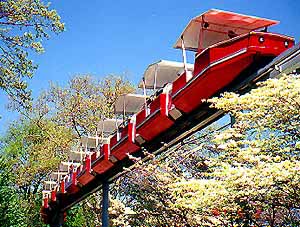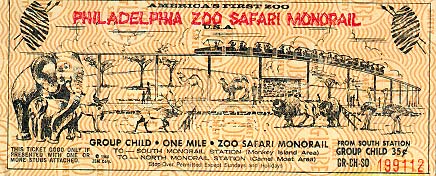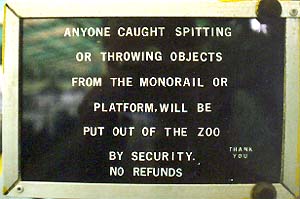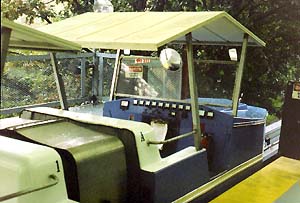Novelty Monorails - Philadelphia Zoo, Pennsylvania
by David B. Simons Jr.

photo by Andy Andersen
The Philadelphia Zoo Safari Monorail is billed as the first
zoo monorail at America's first zoo. The system was installed
in 1969 by Universal Design Limited, and is similar to the monorail
system that ran at HemisFair in San Antonio, Texas and the one
still in operation at Geauga Lake Park [now Six Flags Over Ohio]
in Aurora, Ohio. To my knowledge, the Ohio system is the only
one of this type of monorail to enjoy accident free service. More
on that later.
Other UDL monorails in this county run at Dutch Wonderland [two
of their original UDL trains have been replaced], Riverside Park
[dismantled since this article first appeared in MONORAIL newsletter],
and the State Fair of Oklahoma. While most UDL systems run on
steel track, the Riverside monorail's beam is partly wood, while
the Oklahoma system enjoys the distinction of being the only concrete
tracked UDL monorail in existence. You may recall from my coverage
of Dutch Wonderland (Summer 1995) that I labeled these trains
as "tube-type", since they look like five beer cans
laid end to end on the track. The Philadelphia Zoo has the other
type of UDL train; the "golf cart" [very scientific,
I know]. These trains actually have eleven cars that look like
60's style golf carts hooked together and are open to the air
on all sides, unlike the tube trains where one is enclosed inside
the car.
 The Safari Monorail
began service with three trains, in the obligatory colors: red,
blue, and green. At one point in their history, zoo officials
had to retire the green train, due to being run off the track
at an open switch while attempting to get to the maintenance facility.
(There's a long story behind this and propriety dictates we not
discuss it in front of children and light rail fans; it was not
a flaw of the monorail system. Let's leave it as "human error
induced by anticipation of a mid-afternoon coupling--and not of
two trains".) This train's cars sit beneath a building at
the zoo awaiting repainting and re-installatin. The system did
not enjoy a reputation for safety until recent years when a new
maintenance staff was put in place. Bob Halpine, former General
Manager of the system (for the concessionaire that runs the system),
has described the difficulties he had in bringing the system up
to safe standards. Some of Halpine's improvements to the system
have included 7.5 horsepower motors to replace the stock 5 horse
units that constantly stranded trains when they burnt out trying
to negotiate the small hills on the track. The inspectors who
certify the system for operation also required that the trains
be retro-fitted with an automatic fire extinguisher system. The
system runs in roughly a mile long circle with two stations at
opposite ends of the park, appropriately named North Station and
South Station. One would think that this would qualify the system
for inclusion in the transportation section of this publication,
but since there are times when it is used as a round-trip-only
ride, we'll include it as a "novelty." The Safari Monorail
began service with three trains, in the obligatory colors: red,
blue, and green. At one point in their history, zoo officials
had to retire the green train, due to being run off the track
at an open switch while attempting to get to the maintenance facility.
(There's a long story behind this and propriety dictates we not
discuss it in front of children and light rail fans; it was not
a flaw of the monorail system. Let's leave it as "human error
induced by anticipation of a mid-afternoon coupling--and not of
two trains".) This train's cars sit beneath a building at
the zoo awaiting repainting and re-installatin. The system did
not enjoy a reputation for safety until recent years when a new
maintenance staff was put in place. Bob Halpine, former General
Manager of the system (for the concessionaire that runs the system),
has described the difficulties he had in bringing the system up
to safe standards. Some of Halpine's improvements to the system
have included 7.5 horsepower motors to replace the stock 5 horse
units that constantly stranded trains when they burnt out trying
to negotiate the small hills on the track. The inspectors who
certify the system for operation also required that the trains
be retro-fitted with an automatic fire extinguisher system. The
system runs in roughly a mile long circle with two stations at
opposite ends of the park, appropriately named North Station and
South Station. One would think that this would qualify the system
for inclusion in the transportation section of this publication,
but since there are times when it is used as a round-trip-only
ride, we'll include it as a "novelty."
 On two separate occasions,
I've tried to photograph and ride the monorail at the zoo, but
both attempts have been futile. The first visit was in January
of 1996 [during which season the monorail doesn't run anyway],
on the day after the zoo's primate house was destroyed by fire.
Understandably, after losing some of the zoo's primates, nobody
was answering phones that day [let alone letting in a monkey with
a camera!]. On two separate occasions,
I've tried to photograph and ride the monorail at the zoo, but
both attempts have been futile. The first visit was in January
of 1996 [during which season the monorail doesn't run anyway],
on the day after the zoo's primate house was destroyed by fire.
Understandably, after losing some of the zoo's primates, nobody
was answering phones that day [let alone letting in a monkey with
a camera!].

The second was in August of the same year with various TMS members and officials in attendance. We arrived on the monorail
platform just before a moderate thunderstorm began its downpour.
While waiting for the blue train to pick us up [I had convinced
our party not to board the red train when we had the chance because
no seats were available in the forward most or rear-most cars;
the best location from which to take a picture of the train from
the vehicle as it negotiates curves.], the loader announced in
a happy voice that they were all going to get to go home early.
This monorail doesn't run in the rain! Foiled again! Now I have
to make yet another trip to the Northeast, but with the discovery
of several New Jersey novelty monorails [and the extension to
the Newark International Airport monorail], there will be more
reasons to go.
Note: this monorail was removed in 2002.
 / back to the Novelty Monorails
index / back to the Novelty Monorails
index |

 The Safari Monorail
began service with three trains, in the obligatory colors: red,
blue, and green. At one point in their history, zoo officials
had to retire the green train, due to being run off the track
at an open switch while attempting to get to the maintenance facility.
(There's a long story behind this and propriety dictates we not
discuss it in front of children and light rail fans; it was not
a flaw of the monorail system. Let's leave it as "human error
induced by anticipation of a mid-afternoon coupling--and not of
two trains".) This train's cars sit beneath a building at
the zoo awaiting repainting and re-installatin. The system did
not enjoy a reputation for safety until recent years when a new
maintenance staff was put in place. Bob Halpine, former General
Manager of the system (for the concessionaire that runs the system),
has described the difficulties he had in bringing the system up
to safe standards. Some of Halpine's improvements to the system
have included 7.5 horsepower motors to replace the stock 5 horse
units that constantly stranded trains when they burnt out trying
to negotiate the small hills on the track. The inspectors who
certify the system for operation also required that the trains
be retro-fitted with an automatic fire extinguisher system. The
system runs in roughly a mile long circle with two stations at
opposite ends of the park, appropriately named North Station and
South Station. One would think that this would qualify the system
for inclusion in the transportation section of this publication,
but since there are times when it is used as a round-trip-only
ride, we'll include it as a "novelty."
The Safari Monorail
began service with three trains, in the obligatory colors: red,
blue, and green. At one point in their history, zoo officials
had to retire the green train, due to being run off the track
at an open switch while attempting to get to the maintenance facility.
(There's a long story behind this and propriety dictates we not
discuss it in front of children and light rail fans; it was not
a flaw of the monorail system. Let's leave it as "human error
induced by anticipation of a mid-afternoon coupling--and not of
two trains".) This train's cars sit beneath a building at
the zoo awaiting repainting and re-installatin. The system did
not enjoy a reputation for safety until recent years when a new
maintenance staff was put in place. Bob Halpine, former General
Manager of the system (for the concessionaire that runs the system),
has described the difficulties he had in bringing the system up
to safe standards. Some of Halpine's improvements to the system
have included 7.5 horsepower motors to replace the stock 5 horse
units that constantly stranded trains when they burnt out trying
to negotiate the small hills on the track. The inspectors who
certify the system for operation also required that the trains
be retro-fitted with an automatic fire extinguisher system. The
system runs in roughly a mile long circle with two stations at
opposite ends of the park, appropriately named North Station and
South Station. One would think that this would qualify the system
for inclusion in the transportation section of this publication,
but since there are times when it is used as a round-trip-only
ride, we'll include it as a "novelty." On two separate occasions,
I've tried to photograph and ride the monorail at the zoo, but
both attempts have been futile. The first visit was in January
of 1996 [during which season the monorail doesn't run anyway],
on the day after the zoo's primate house was destroyed by fire.
Understandably, after losing some of the zoo's primates, nobody
was answering phones that day [let alone letting in a monkey with
a camera!].
On two separate occasions,
I've tried to photograph and ride the monorail at the zoo, but
both attempts have been futile. The first visit was in January
of 1996 [during which season the monorail doesn't run anyway],
on the day after the zoo's primate house was destroyed by fire.
Understandably, after losing some of the zoo's primates, nobody
was answering phones that day [let alone letting in a monkey with
a camera!].